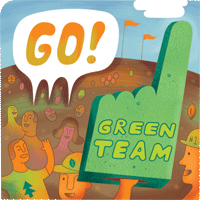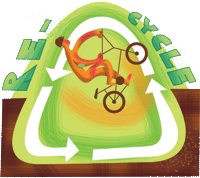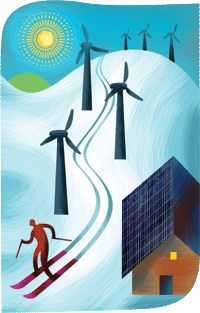Go! Green Team
Super Bowl XLII piled up 1,000 tons of trash. A Formula One racecar spews 60,000 pounds of carbon dioxide in one season, five times more than a typical car in a year. Golf course water sprinklers spray about 312,000 gallons a day. That’s equal to 86,667 toilet flushes. Sports can take a toll on our environment, but many athletes and sports organizations are going green.
Green: The New Gold
 For a city to play host to the Olympics, the International Olympic Committee requires it to have a plan to help the environment. As one of the most polluted cities in the world, 2008 host city Beijing, China, faced big challenges. The Chinese government has spent more than $12 billion to put on a “green” Olympics this month.
For a city to play host to the Olympics, the International Olympic Committee requires it to have a plan to help the environment. As one of the most polluted cities in the world, 2008 host city Beijing, China, faced big challenges. The Chinese government has spent more than $12 billion to put on a “green” Olympics this month.
Throughout Olympic Park, solar, wind and geothermal power heats water and cools buildings. Eco-friendly buses and rail lines shuttle millions of people.
The National Aquatics Center is covered by more than 3,000 panels that save energy by soaking in and trapping the sun’s warmth and light, like a greenhouse. The National Stadium can recycle 100 tons of rainwater per hour.
On the Ball
 Pulling off an event like the Super Bowl takes loads of electricity, and transportation to the big game uses tons of gas. To help offset all that fuel-burning, the National Football League planted 42 acres of trees in Arizona for this year’s Super Bowl. And thanks to the NFL’s recycling program, 70 percent of the 1,000 tons of trash escaped the landfill.
Pulling off an event like the Super Bowl takes loads of electricity, and transportation to the big game uses tons of gas. To help offset all that fuel-burning, the National Football League planted 42 acres of trees in Arizona for this year’s Super Bowl. And thanks to the NFL’s recycling program, 70 percent of the 1,000 tons of trash escaped the landfill.
The NFL’s Philadelphia Eagles sport green in more ways than on their jerseys. The team prints tickets and programs with recycled paper and runs its offices and training facility on solar power. Also, the team has announced plans for the Eagles Forest near Philadelphia. The native trees and shrubs planted here will help offset energy used when the team travels.
Setting an X-ample
 The X Games makes recycling fun. Fans who “Get Caught Recycling” earn tokens when they toss trash into recycling bins and carpool or take public transportation to the event. Fans can trade the tokens for cool stuff at the TRASHed Recycling Store.
The X Games makes recycling fun. Fans who “Get Caught Recycling” earn tokens when they toss trash into recycling bins and carpool or take public transportation to the event. Fans can trade the tokens for cool stuff at the TRASHed Recycling Store.
In some dining areas, utensils and cups are made from biodegradable corn starch and sugar cane. And all the grease from burgers and fries? Turned into earth-friendly biodiesel fuel.
Skiing Into the Future
 Aspen Ski Resort in Colorado was the first U.S. ski resort to offset energy use with wind power, and its snowcats run on biodiesel.
Aspen Ski Resort in Colorado was the first U.S. ski resort to offset energy use with wind power, and its snowcats run on biodiesel.
The world’s first solar- and wind-powered chairlift is at Colorado’s Steamboat resort. The biggest green resort village in North America is coming to Vail, Colo. It will be all about alternative energy, recycling, use of natural light and conservation.
Greener Greens
 More than 16,000 golf courses cover 1.5 million acres of U.S. land. That’s bigger than the state of Delaware. Creating golf courses destroys natural habitats, and chemical pesticides and fertilizers pollute ground water.
More than 16,000 golf courses cover 1.5 million acres of U.S. land. That’s bigger than the state of Delaware. Creating golf courses destroys natural habitats, and chemical pesticides and fertilizers pollute ground water.
Many golf courses are starting water-recycling programs; planting native trees, shrubs and grasses (which require less watering); switching to electric or biodiesel carts; and using natural fertilizers and anti-pest methods.
Waving the Green Flag
 The car-racing world is cutting down its carbon “tire track.” NASCAR has switched to less-polluting unleaded gas. The Indy Racing League and Formula One circuit use ethanol and biofuels.
The car-racing world is cutting down its carbon “tire track.” NASCAR has switched to less-polluting unleaded gas. The Indy Racing League and Formula One circuit use ethanol and biofuels.
And who knows what the future holds? Engineers in England have built a biodegradable racer named Eco One. Its body is made from plant materials; tires from natural rubber and potato starch; brakes from plant materials and cashew nut oil; engine and chassis from recyclable steel. It runs on biofuel, and it is fast: 0 to 62 miles per hour in four seconds with a top speed of 150 m.p.h.
Some drivers are going green, too. NASCAR champ Ward Burton started a wildlife foundation for habitat preservation and kid-friendly environmental education. “However big or however small,” Burton says, “we all can make a difference.”
The Ball’s in Your Court
Saving the environment isn’t just up to the pros. You can do your part:
- Use reusable water bottles.
- Ride your bike, walk, bus or carpool to games and practices. A four-mile bicycle trip keeps about 15 pounds of pollutants out of the air.
- Take a shorter shower after practice or the game.
- Organize recycling programs at local parks.
- See if the ski resort where you’re going offers a SkiGreen Tag, which helps offset travel pollution with clean energy.
- Buy a tree for the Eagles Forest (click here)
Green Your Gear
Ball, bat and other sports-equipment production uses energy and materials. Conserve these resources by buying top-notch stuff that lasts or by buying used gear. You can also get equipment made from Earth-friendly materials. Here are just a few sources:
- Swing away at biodegradable golf balls and tees from www.ecogolf.com and www.ecogolfballs.com.
- Get eco-friendly surf-, skate- and snow boards at www.arborsports.com.
- Consider carbon-neutral outfitters like Escape Adventures, the world’s first. www.escapeadventures.com
Thats so Amazing!!!!
I think it was inspiring
COOL
this is one of the nicest go green websites ever!!!!!!!!!!!!!!! how can i help